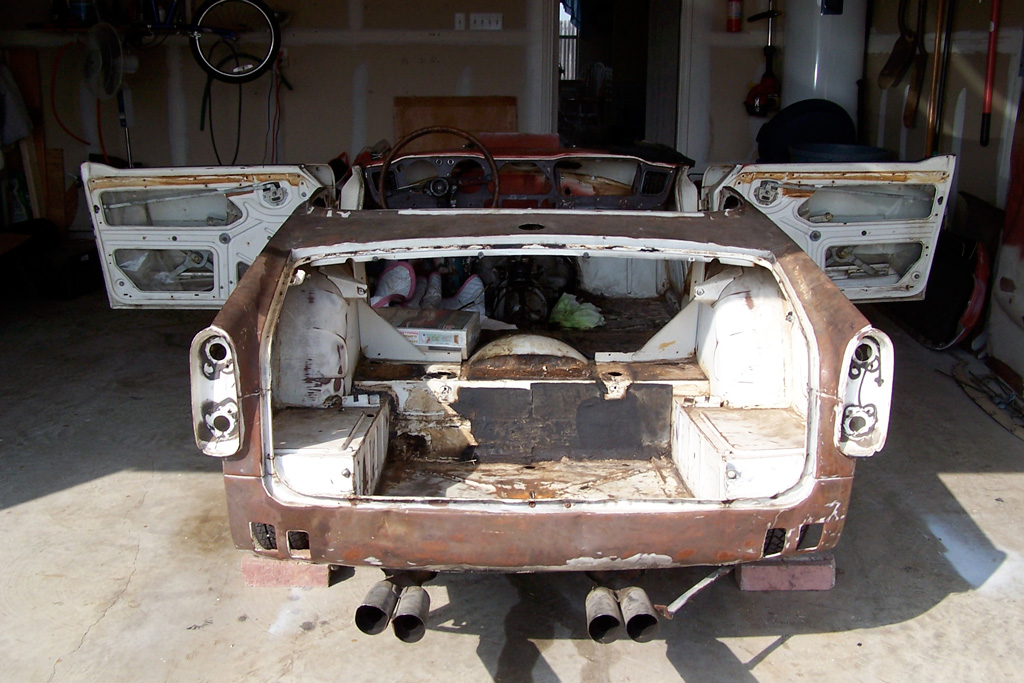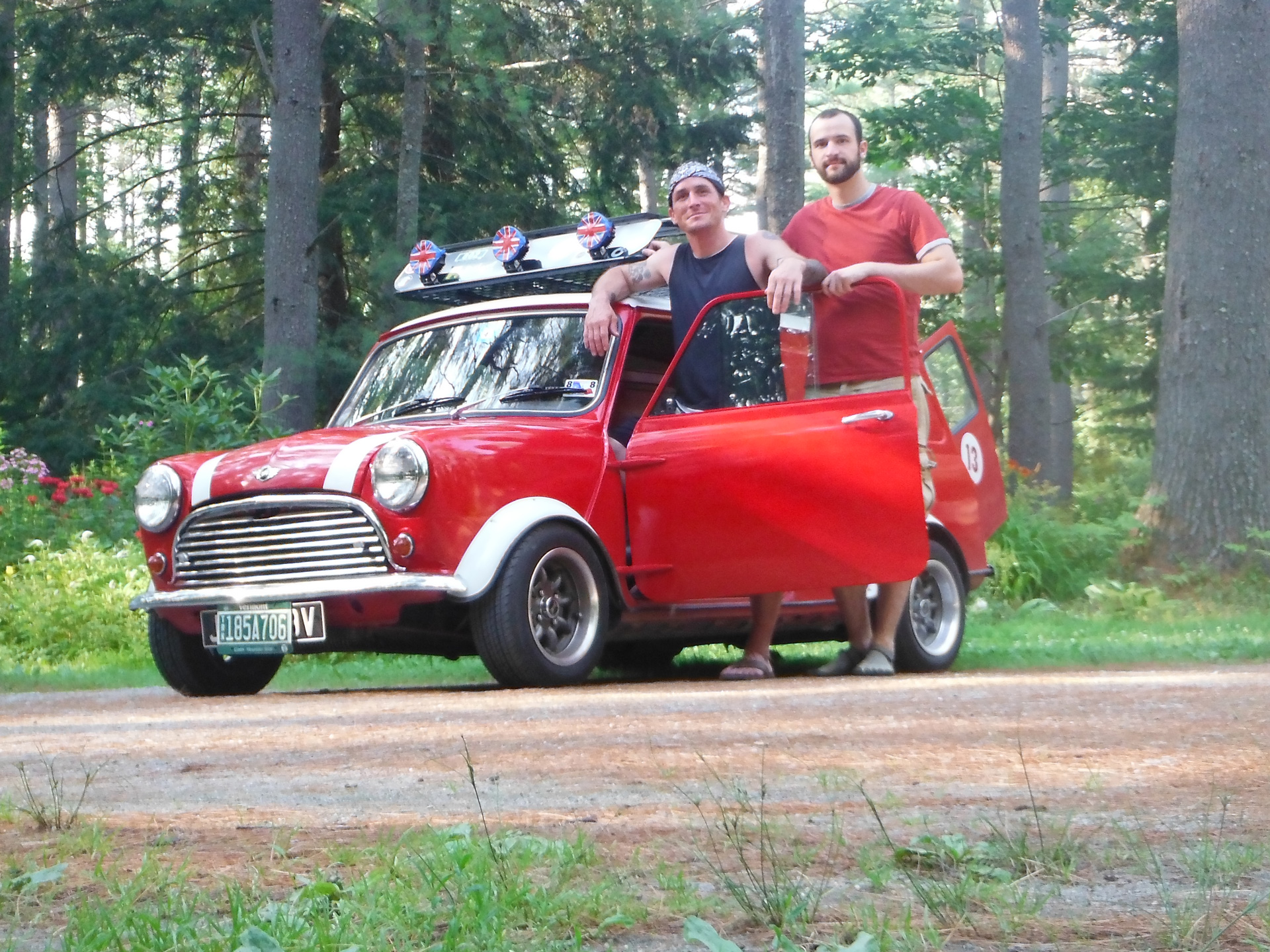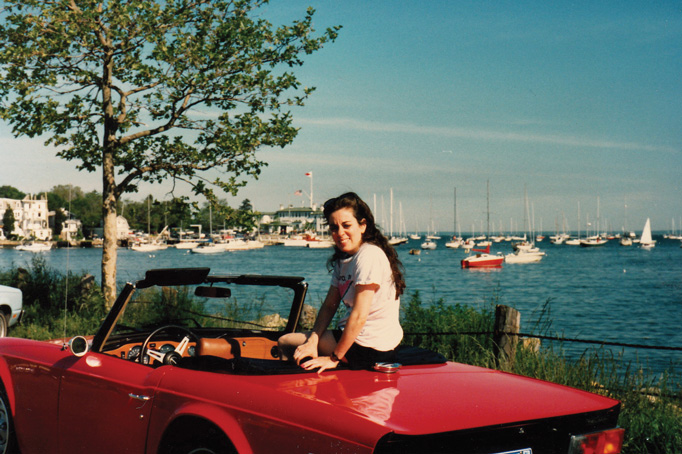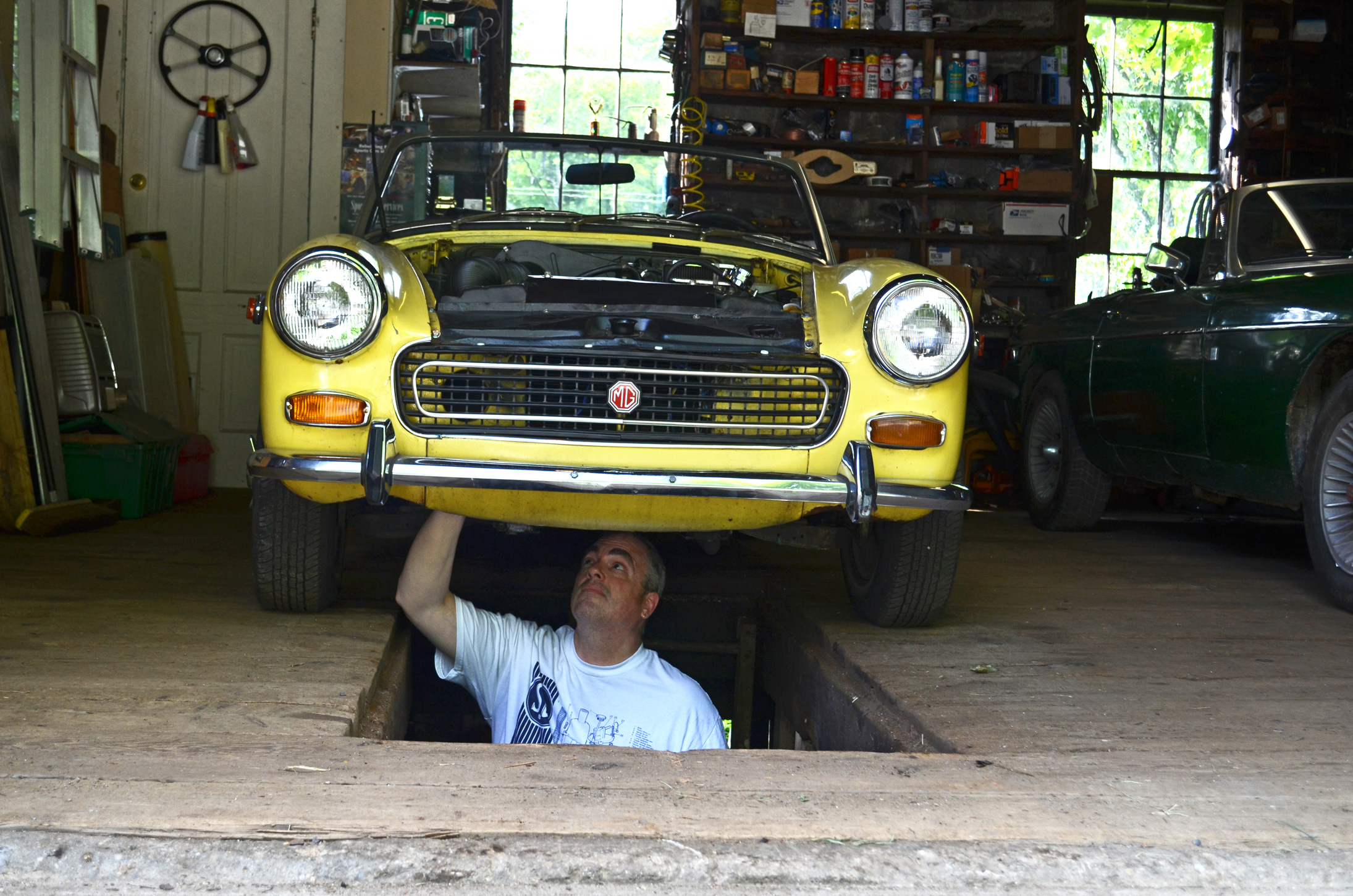It was a stunning Sunday afternoon in Texas, a top down day if there ever was one. As I drove with a cigar set firmly between my teeth, I took in all the senses that only a car like this can provide, senses poetically described by the rock band Rush, in a song from their album Moving Pictures, about a young man and his white-haired uncle’s “Red Barchetta.”

Mom and her “new” TR4A with the old Dallas warehouse district in the background.
“Well-weathered leather,
Hot metal and oil,
The scented country air.
Sunlight on chrome,
The blur of the landscape,
Every nerve aware.”
This drive was the first of many to follow. But as I drove that day, I couldn’t help but remember how I got to this moment, and how much effort, time and resources it took.
The car, which I have recently named “Daphne” (wanting a distinctively British sounding lady’s name), was given to me by my mother after years of insufferable begging. It came to her by way of the neighbor across the street, who was storing it in his garage for a friend. Mom noticed this little car going nowhere—a sign of things to come—and inquired if it might be for sale. Well, after a couple of weeks, and around $1200 later, it made a home in our garage.
I was sixteen and I had this chick-magnet of a sports car to drive whenever mom allowed—which wasn’t much. Not only did she protect the car, but it had a tendency to not want to start, too. Still, I drove this thing as often as I could until that fateful day when my family, and the car, moved out to California while I stayed behind in Texas to finish high school.
While in California mom had some restoration work done. The car’s interior was stripped, the engine removed and some bodywork was performed. But, as so often happens in life, things changed quickly and my family moved back to Texas. With the car now partially assembled, and a lot of it in boxes, it went into storage for roughly sixteen years, interrupted by a couple trips to local garages to have work done.
 And yet my mother loved that little car and wanted to spend more time driving it herself. No matter how I reasoned with her for it, she wouldn’t let go. Cars like this represent something inside their owners, and I think for mom, it was an outlet for the young, adventurous woman who enjoyed turning heads driving a spirited vintage Triumph. To put it plainly: it was fun, beautiful and vibrant—all qualities moms the world over need more of in their lives. Finally, in May 2003 she let go, and the car was trailered to my home.
And yet my mother loved that little car and wanted to spend more time driving it herself. No matter how I reasoned with her for it, she wouldn’t let go. Cars like this represent something inside their owners, and I think for mom, it was an outlet for the young, adventurous woman who enjoyed turning heads driving a spirited vintage Triumph. To put it plainly: it was fun, beautiful and vibrant—all qualities moms the world over need more of in their lives. Finally, in May 2003 she let go, and the car was trailered to my home.
OK…I finally had it. Now what to do?
I did nothing. That’s right, nothing!
Triumphology
Before I did anything material, I resolved to study. First, I became a book-smart expert on the car itself. Second, I studied the ins-and-outs of auto restoration. To accomplish these objectives I bought and read books, searched out and read various web sites, joined my local Triumph club, subscribed to online email lists and devoured the Bentley Manual and Moss parts catalog. I broke this study down by major systems, because that is how all the manuals and parts catalogs break it down. I used Roger Williams’ How to Restore TR4 and TR4A to get a feel for the order of restoration, any gotchas I could expect, and compared this content from the book with what I was hearing from others. After about nine months of research, and spending weekends poking around the car itself, which included getting the engine running and going for a short drive, I decided it would be worth the effort, and I was ready to take on the project.
In January of 2004 I started my restoration plan with my eyes wide open to the fact that this was going to be a major undertaking. Nine years later I can say that my expectations were dead-on. A full, frame-off restoration, like marriage, should not be entered into lightly! It takes commitment, money, time and lots of patience. But like a good marriage, despite all the setbacks and mistakes, you get something out of it greater than what you put in.
When I was ready to get down to work I trailered the car to my father’s-in-law shop. To my great fortune, my father-in-law is Bill Griffith of Bigger Hammer Racing, a well-known Formula Vee racer. He lent me space in the second bay of his shop and offered the use of his tools, contacts and personal expertise—a tremendous help indeed.
 After removing all the body panels, I rigged up several pulleys from the rafters. Using aircraft cable and a manual winch, I raised the body tub from the chassis and suspended it in the air while I worked on the car below.
After removing all the body panels, I rigged up several pulleys from the rafters. Using aircraft cable and a manual winch, I raised the body tub from the chassis and suspended it in the air while I worked on the car below.
Eventually I had everything removed from the chassis. All of the parts got labeled and stored. Small parts went into freezer bags, larger parts into cardboard and plastic boxes. I had bags of bags and boxes of boxes. My labeling and storage, like the project itself, was broken down by system. Using this method of organization I never lost a part and knew exactly where to find everything.
As the years went by, myself and my three children would work on the project when we could. All of them can point to something on the car and say, “I did that.” I hadn’t realized it at the time, but now I see that they share pride in the car, same as me, and it will always represent something we did together.
In the end I hired-out all welding, bodywork, painting, and the rebuilding of the gearbox, carburetor, distributor and rocker assembly. I did everything else myself; and if I can do it, you can do it too. After completing the work, just before my 40th birthday in September 2011, I sent the completed car to a local British shop to have them do a “once-over” to ensure it was safe to drive, and would perform as expected. After they tweaked a few things, it got a clean bill of health and was on the road for the first time since 1988.
Daphne needed to have a coming-out party, I felt. Folks in my local Triumph club would have been justified if they believed I only imagined having a TR4A. I would attend car shows, and ask a lot of questions, but never brought the car to them, nor them to the car. But in the spring of 2012, my wife Julie and I drove her to the VTR South Central Region Convention held in Broken Arrow, Oklahoma.
As happy as I was to be among Triumph friends, it cannot compare to the feeling of pride and thankfulness I felt when I presented the car to mom just weeks before. She was up from the coast visiting and I was just itching to get her behind the wheel to show her just how smart she was for turning the car over to me. It was also a chance for me to show that I had fulfilled my promise to get the project done. Well, she drove it a bit that day, and I hope to get her behind the wheel a lot more. Her only criticism was that the clutch is “real stiff,” which to me only confirms that I did my job by the book, as a stiff clutch is a common feature on most older Triumphs.
There is a deep satisfaction in driving a vintage sports car that you rebuilt yourself. It proves my mom’s constant lesson in my youth that “if you want it bad enough, you can do anything.”
Even though I know Daphne is a machine, she is a beautiful machine from the earliest days of my driving experience, which gives her a “soul.” I feel that most vintage British cars have a soul to them, which is a virtue that comes, like the Rush song says, “from a better, vanished time.”
By Guy Huggins












'Mom’s Car' has 1 comment
October 6, 2013 @ 5:14 pm Gary Drumm
Way to go Guy! Great work. It’s awesome to see that beautiful lady running again.